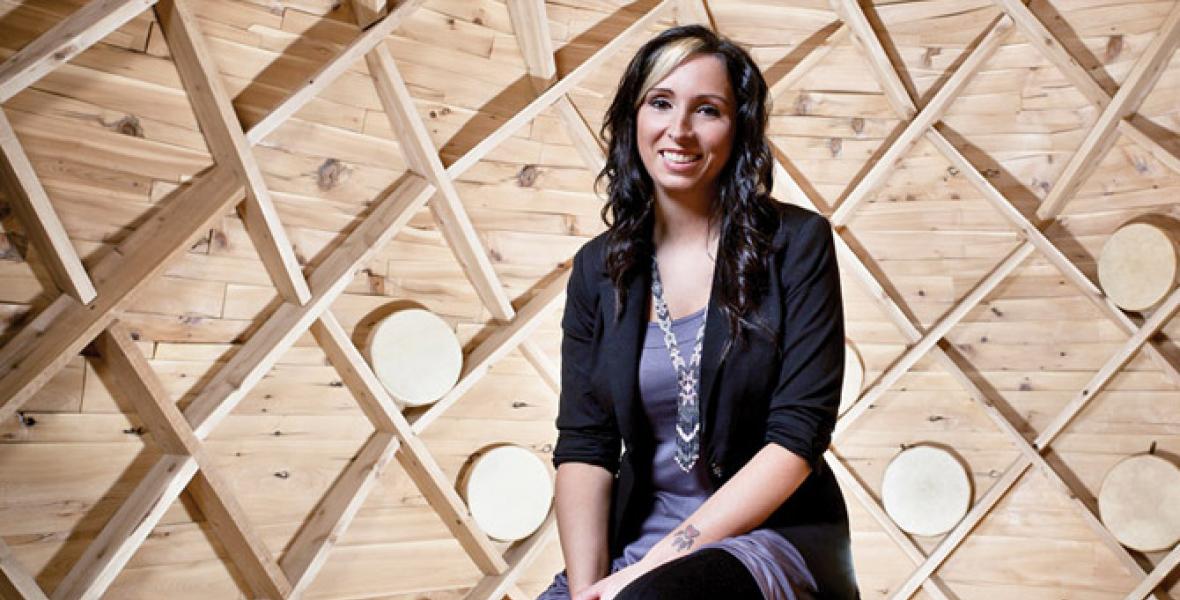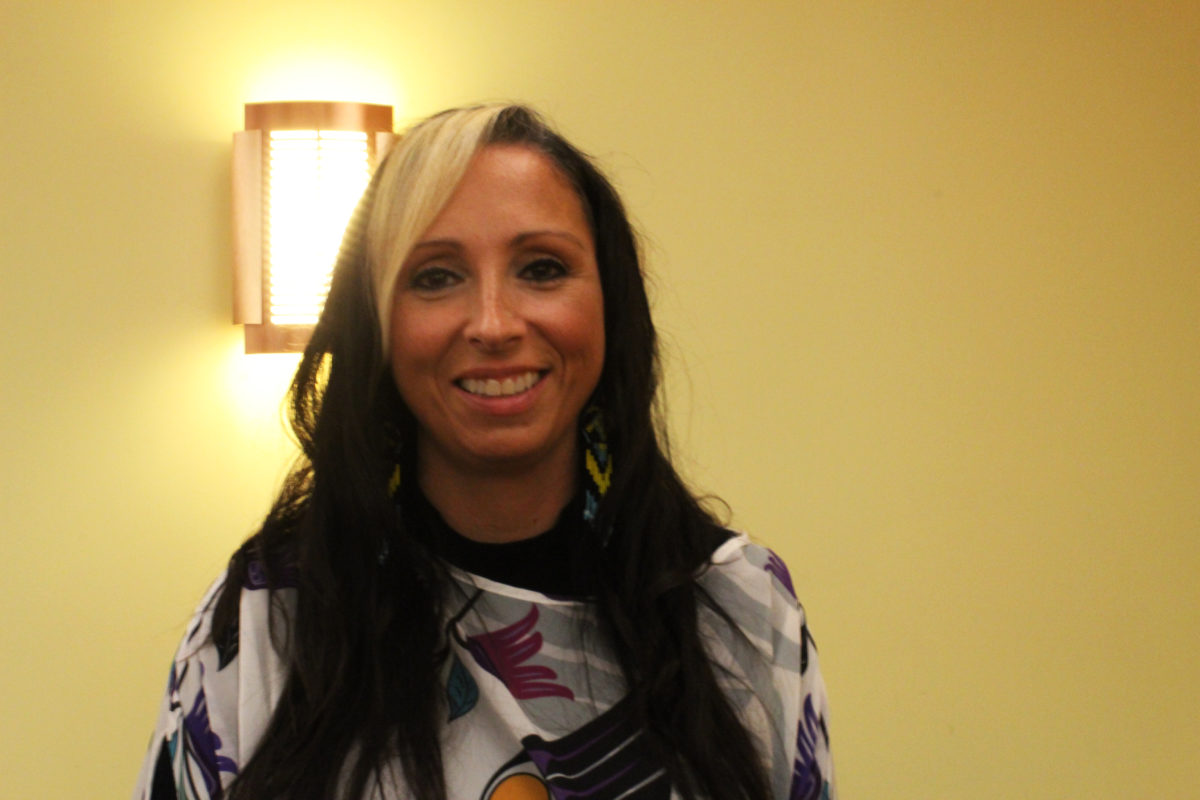

Pam Palmater spoke powerfully to the crowd in Kinsella Auditorium, calling for the national inquiry on missing and murdered Indigenous women to be based on a human rights framework.
“The reason we have murdered and missing Indigenous women is because of Canada’s continued failure to implement, recognize, protect and enforce human rights of Indigenous women and girls,” Palmater said.
Palmater, a Mi’kmaq lawyer, professor and social justice activist, delivered the annual Vigod Memorial Lecture in Human Rights on Nov. 2 at St. Thomas University.
Palmater, of Eel River Bar First Nation in northern New Brunswick, studied at STU and went on to earn a law degree at Dalhousie University. She is currently the chair in Indigenous governance at Ryerson University.
She’s won numerous awards, including the Margaret Mead Award in Social Justice 2016 and has been named one of the Canadian Lawyer Magazine’s 2013 top five most influential lawyers in the human rights category.
The lecture started with a video honouring missing and murdered Indigenous women with music by A Tribe Called Red.
After the video, she took the audience on a path through the history of Indigenous women and the genocidal effects of colonization.
Indigenous women have always played an important and integral role in their society, Palmater said.

“They weren’t just life-givers … They were sovereign as individuals and they contributed to the sovereignty, safety and security of their nations, as leaders, negotiators, political strategists, traders, interpreters,” she said.
“We [Indigenous women] are still strong, loving, powerful and formidable.”
Palmater said Indigenous women refuse to give up, no matter the circumstances, but it is because of this strength that they have been targeted.
“Unfortunately, it is also because of our strength and power and love and caring that colonial governments targeted Indigenous women and children and they targeted them for a very particular reason — because they knew that we were the heart of our nation.”
Palmater described the hideous and heinous ways in which settler governments assimilated and eliminated Indigenous peoples.
“And it’s the elimination part that we haven’t quite gotten our minds around yet, haven’t felt comfortable to talk about,” she said.
She said it’s a lot easier to talk about assimilation and the loss of culture “as if it would happen eventually overtime through contact — like it just fell out of your pocket one day.”
“It’s a lot harder to talk about killing people, it’s a lot harder to talk about what really happened in this territory,” she said.
From the very early days of contact, police officers worked to keep Indigenous peoples trapped on reserves and used food rations to extort and sexually exploit Indigenous women and little girls.
“That’s the founding of our country … from the Northwest Mounted Police all the way up to modern day policing,” she said.
Palmater touched on the residential school system, where children were ripped from their parents and brought to schools where they were beaten, starved and sexually abused, among many other atrocities.
“Forty per cent of those children didn’t make it out of those schools alive,” she said.
Indigenous women were further targeted through sterilization programs across the country.
“Twelve-year-old girls would walk into a doctor’s office with a stomachache and come out sterilized and not know it until they were older and couldn’t have children,” she said.
Forced sterilization and preventing the birth of a particular group of people is an act of genocide under the Rome Statute, of which Canada has signed and ratified.
Palmater quoted a document from the Department of Indian Affairs that stated it was in their interest to server Indigenous women’s relationship with their community in whatever way possible.
“They removed the remaining Indigenous women that were left on the reserve out of politics, out of governance and completely eradicated their voice at the community level and we are still feeling those effects today. That’s how powerful colonization was and is,” Palmater said.
“The basic, basic human rights of Indigenous women and girls are denied on a daily basis and the worst part is that it’s not over. We can’t even move to reconciliation because it hasn’t stopped.”


The denial of basic human rights of Indigenous people and Indigenous women is evidenced by numerous statistics.
The life expectancy of Indigenous women in Canada is upwards of 15 years less then that of the settler populations.
Indigenous women have the highest number of suicide attempts and suicide is the number one leading cause of death for Indigenous youth
In the last 10 years, the imprisonment rate of Indigenous girls has increased by 83 per cent.
“What on earth are we doing in this country?” asked Palmater, adding that it would take 28 years to close the education gap and 63 years to close the income gap.
“You can hold up a beautiful piece of paper that has all of the articles of the United Nation’s Declaration on the Rights of Indigenous Peoples — in fact we’re celebrating its 10 year anniversary — but what does that piece of paper mean if every socio-economic indicator for Indigenous women and girls has gotten worse in the last ten years? … What does that paper mean if no one’s enforcing it?”
In addition to those statistics, there are thousands of Indigenous women who aren’t included in the Indian Act because they’ve been denied status based on their parental lineage.
From 1869 until 1985, if an Indigenous woman married a non-Indigenous man, she and the children of the marriage were denied status. In 1985, the Act was amended by the passage of Bill C-31 to remove discrimination against women. Despite the amendment, gender discrimination persists in the document today. Women who lost status before the 1985 amendment can pass on status to their children, but not their children’s children. Although the amendment does have a reinstatement process for the loss of status, its incredibly difficult to execute the process.
The United Nations has said gender discrimination in the Indian Act is one of the primary causes for murdered and missing Indigenous women.
Prime Minister Justin Trudeau voted against getting rid of
gender discrimination in the Indian Act.
“If our prime minister can’t lead the way, then I’m looking to everyone in this room to,” Palmater said.
“We shouldn’t still be fighting this fight.”
The Inquiry
The national inquiry into missing and murdered Indigenous women was launched last year.
Family hearings have just begun, but so far more have been cancelled than heard and the chief commissioner for the inquiry, Marion Buller, has missed several hearings, said Palmater.
Less than one per cent of Indigenous people have been registered in the national inquiry.
The inquiry has not reached out the homeless, those in shelters, those in prison and children in foster care.
“We are not talking to those who will be the next targets,” Palmater said.
The national inquiry has said it is communicating with people through the website, however many Indigenous people in remote areas don’t have access to a computer or the internet or cell service.
The United Nations has identified the inquiry lacks transparency and accountability.
Palmater said the report based on the findings of the national inquiry so far is lacking as well.
“If you subtract the references, the footnotes, the definitions, the graphics, and the first part which is just promoting the national inquiry … you have a very, very tiny literature review that could have been written by an undergrad student,” Palmater said.
“We want an inquiry, a successful inquiry, but not one that’s going to do more harm.”
Need for a human rights framework
Palmater said that without a revised plan, there are very serious concerns about where the inquiry will go.
The current inquiry looks at the women and “their life choices, their high risk activities that make them vulnerable.”
“What’s happened to Indigenous women and girls is not their fault. They are not the authors of their own misfortune,” Palmater said.
A human rights framework would examine which rights were violated, who they were violated by, why they were violated and what the impact was, how those breaches of human rights can be corrected and how those affected can be compensated.
She called on everyone in the room to stand up for the rights of Indigenous women and girls.
“We cannot let the issue of murdered and missing Indigenous women and girls go the way of prison rates, foster care rates, poverty rates, suicide rates … we simply can’t do it. We owe Indigenous women and girls more than that,” she said, adding that reconciliation is supposed to feel uncomfortable.
“If you went to a Native event or visited a powwow or put artwork in your school, that’s not reconciliation. Reconciliation is uncomfortable. It’s about looking at the uncomfortable truth and taking the hard steps forward.”
Palmater said that Indigenous women refuse to give up, no matter the circumstances, but it is because of this strength that they have been targeted.
“Unfortunately, it is also because of our strength and power and love and caring that colonial governments targeted Indigenous women and children and they targeted them for a very particular reason — because they knew that we were the heart of our nation.”
